Britannia Square House Histories
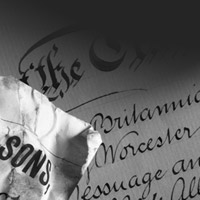
Eastbourne Lodge –
Britannia Square's Missing House
by Robin Dallaway
Britannia Square’s Missing House
Eastbourne Lodge, 54 (previously 51) Britannia Square, once stood at the top south-east corner of the Square, on a plot between the Tything and Britannia Square (see location maps below). It was constructed some time before 1822 and appears on a map by Samuel Mainley of that date. It may have been built by Louis Harvey d’Egville, who had built St. Oswald’s Lodge and had raised money on the house for further speculative building.
Eastbourne Lodge appears to have been a particularly handsome house, with close similarities to others on the east side of the Square, in particular St. Oswald's Lodge (53) and number 50, with their decorative lunettes.
For reasons that we may never be sure of, the house fell into disrepair and on 20th April, 1956 planning permission was granted to demolish it. It was eventually lost sometime after 21st March, 1959 when it was photographed, possibly for the last time, by R. H. Sargeant.
It had also been photographed more extensively on 12th June, 1956 by the National Buildings Register, just several months after it was condemned to demolition. It was further photographed by R. J. Collins in 1959, and originally by G.B. Mason for the National Buildings Register in 1942.
These photographs are featured below.
There are a number of planning documents relating to Eastbourne Lodge available online, but the key application is number R12614, which details the approval of the following: ‘Outline application, Resubmission for the demolition of existing house and the erection of a block of 13 single room self contained flatlets. The application was made by local architects F.E.S. Storer and Partners, on behalf of Principia Holdings Ltd.
Marlow Court, the block of flats which now stands on the site, was built around 1960.
 Eastbourne Lodge, April, 1942. Photograph by G.B. Mason. Source: Historic England Archive.
Eastbourne Lodge, April, 1942. Photograph by G.B. Mason. Source: Historic England Archive.
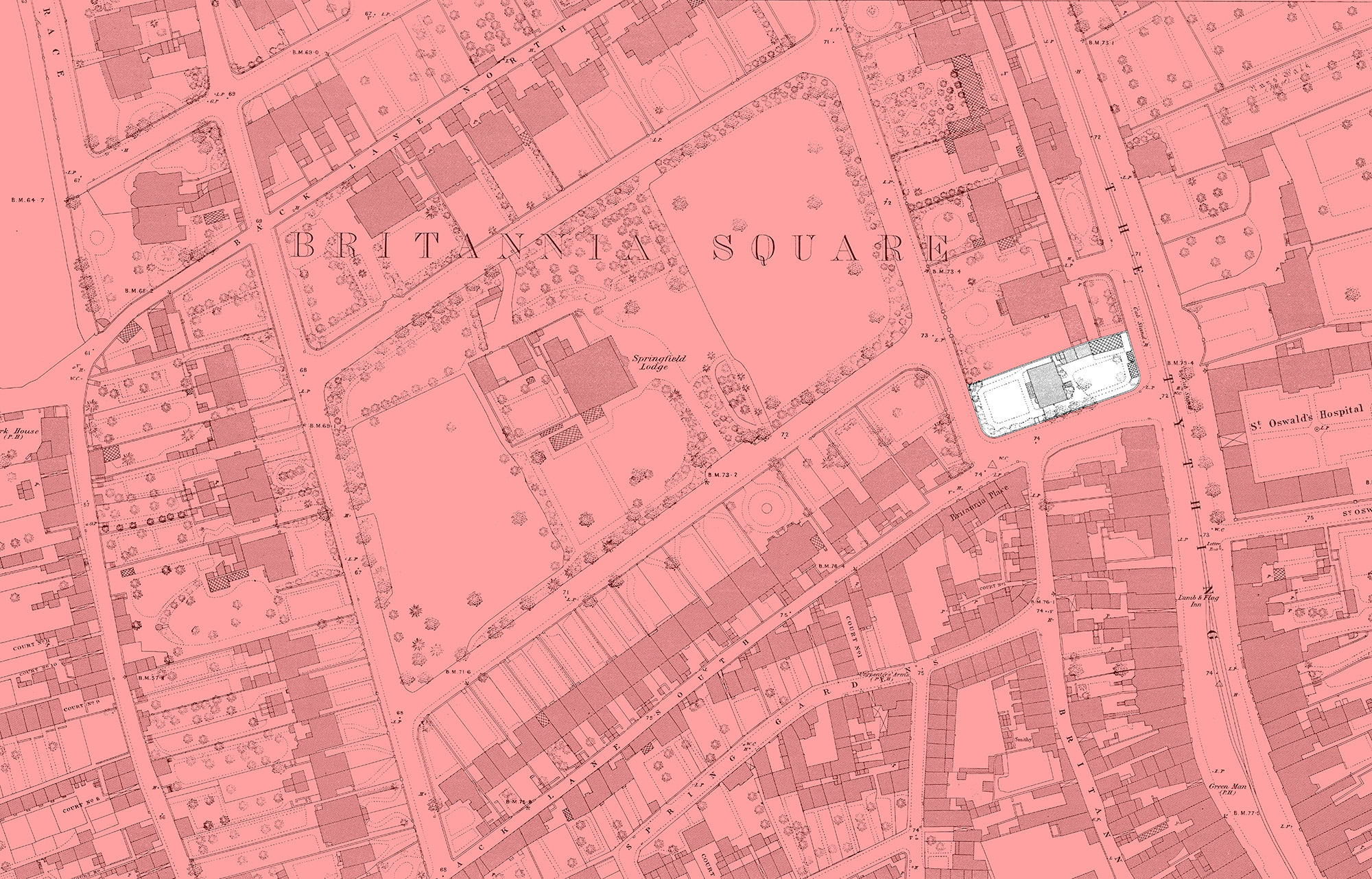
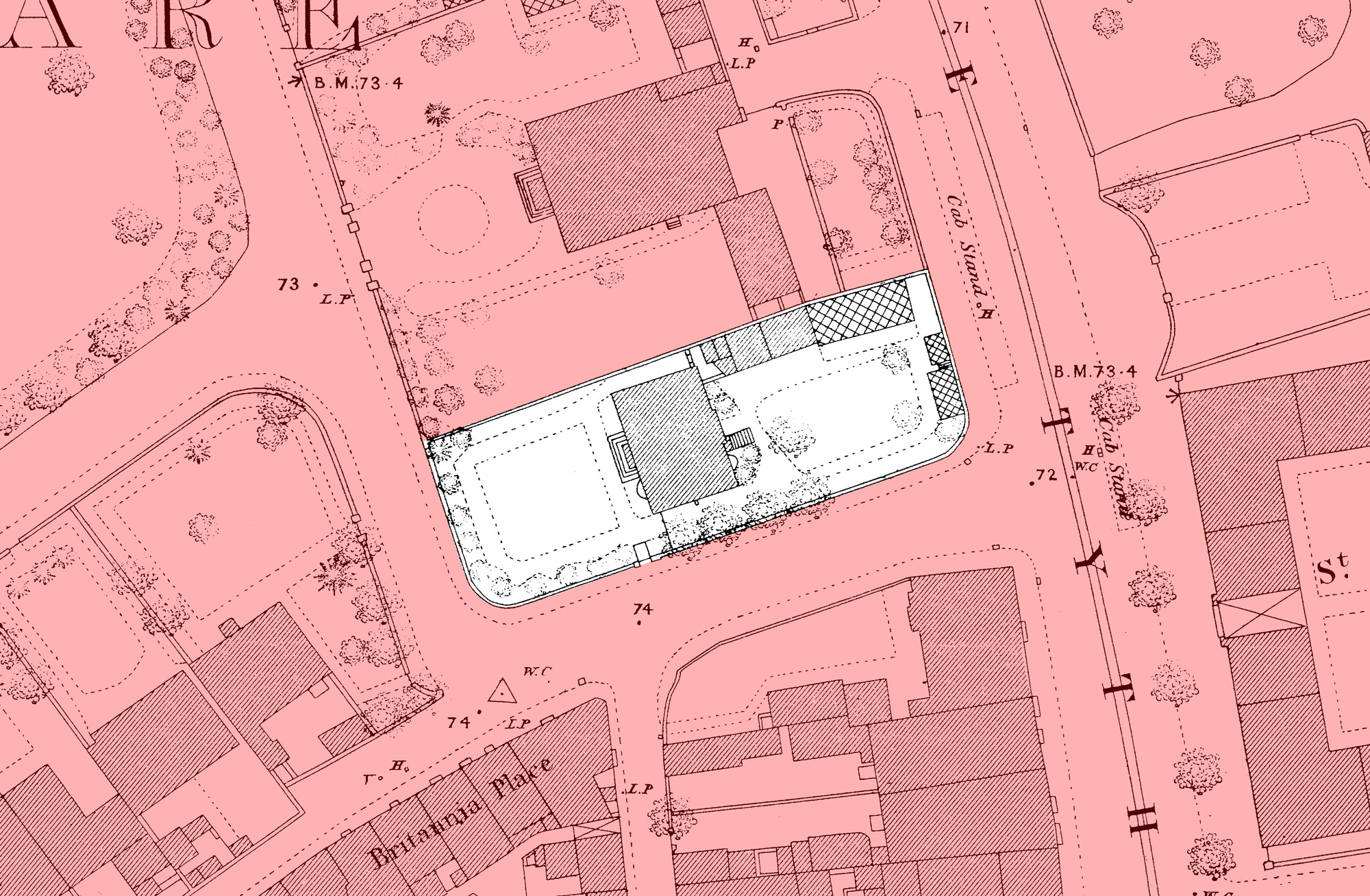 Location maps based on the 1886 Ordinance Survey map.
Location maps based on the 1886 Ordinance Survey map.
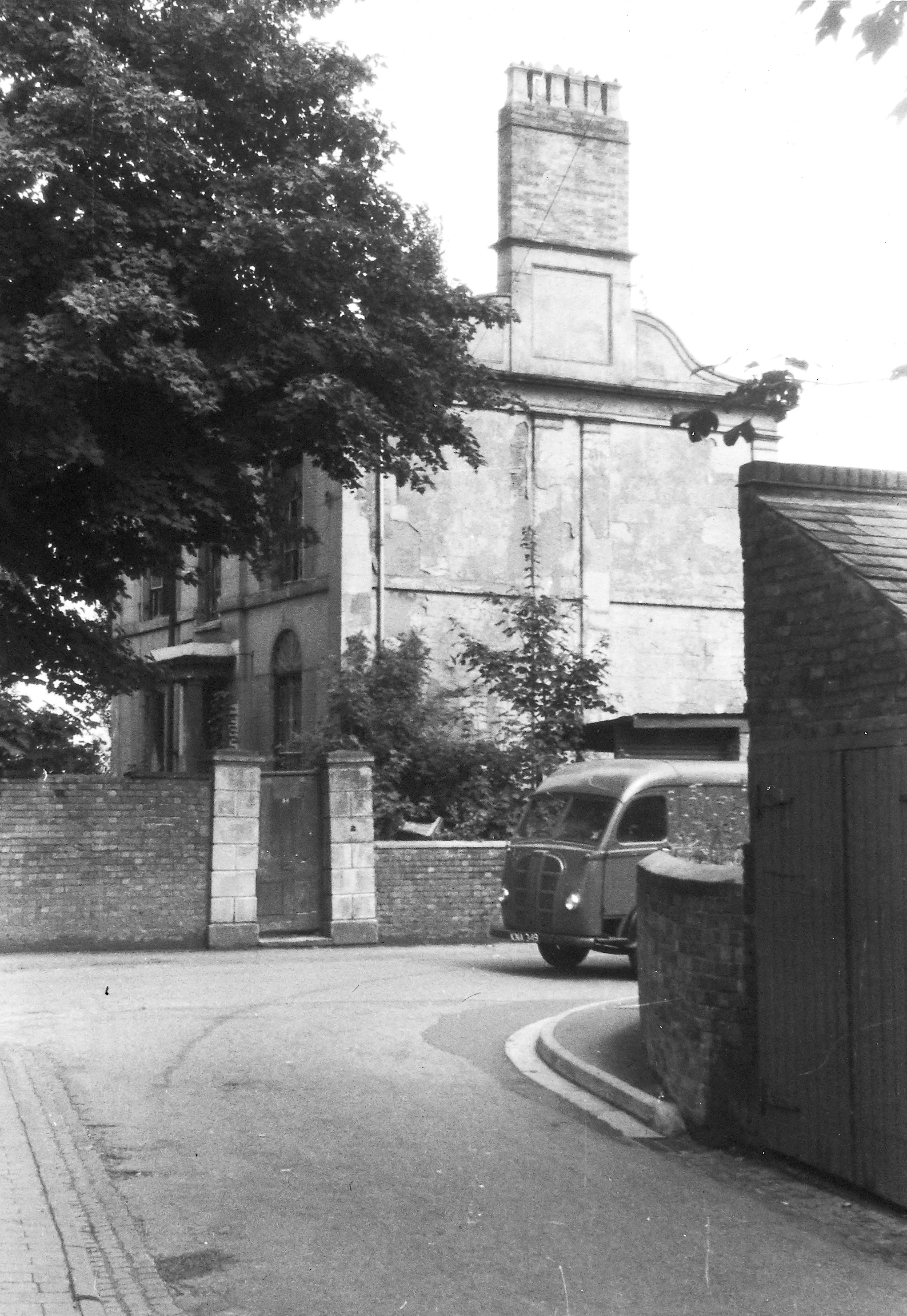 Eastbourne Lodge, 1st August, 1958. Photograph by R.J. Collins, © The Hive, Worcester.
Eastbourne Lodge, 1st August, 1958. Photograph by R.J. Collins, © The Hive, Worcester.
CROP.jpg) Eastbourne Lodge, 12th June, 1956.
Source: Historic England Archive.
Eastbourne Lodge, 12th June, 1956.
Source: Historic England Archive.
CROP.jpg) Eastbourne Lodge, 12th June, 1956.
Source: Historic England Archive.
Eastbourne Lodge, 12th June, 1956.
Source: Historic England Archive.
%20%202054_201%20(54%20Britannia%20Square)%20%202054_200%20(54%20Britannia%20Square)%20.jpg) Eastbourne Lodge, 12th June, 1956.
Source: Historic England Archive.
Eastbourne Lodge, 12th June, 1956.
Source: Historic England Archive.
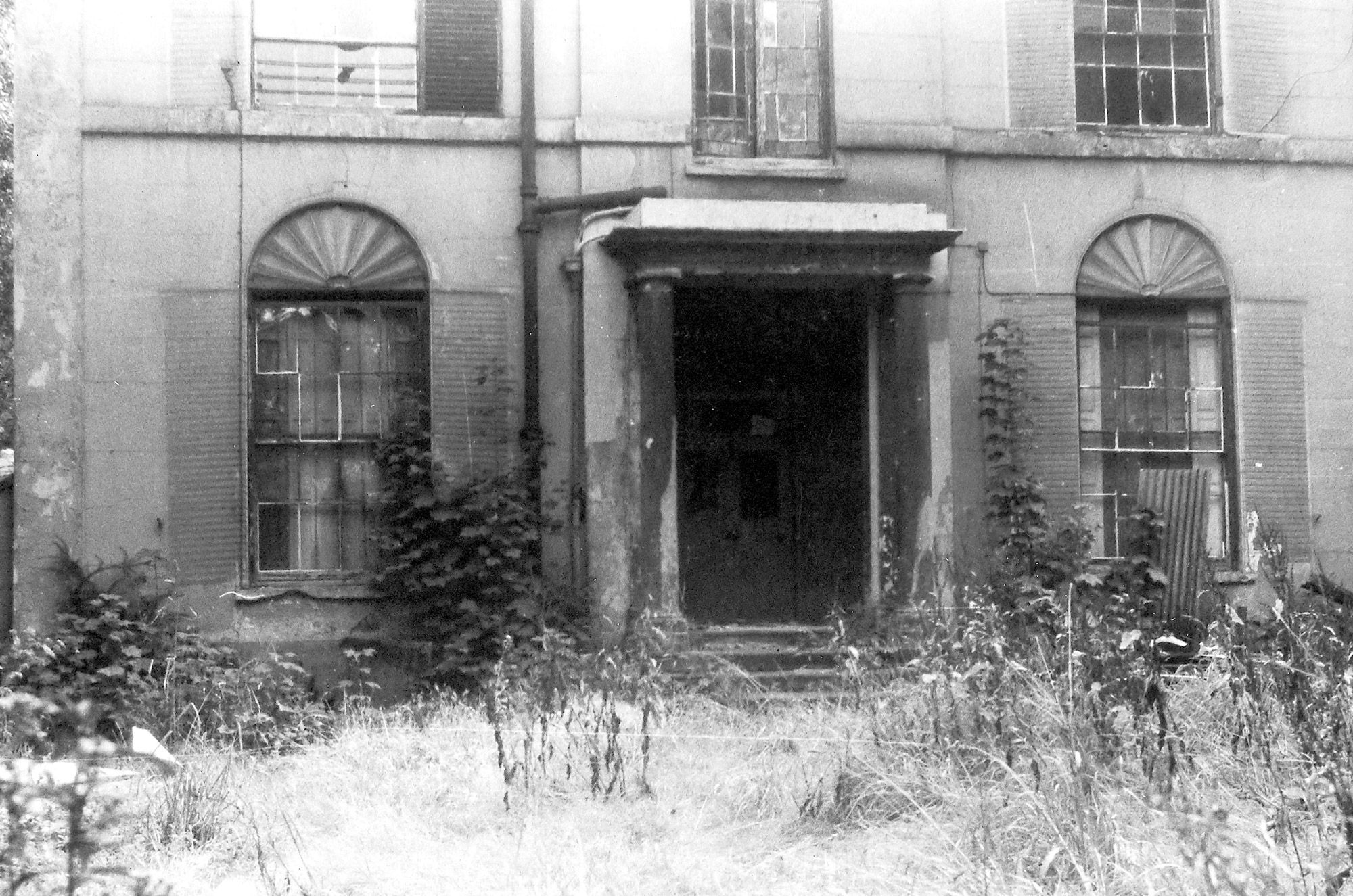 Eastbourne Lodge, 1st August 1958. Photograph by R.J. Collins, © The Hive, Worcester.
Eastbourne Lodge, 1st August 1958. Photograph by R.J. Collins, © The Hive, Worcester.
CROP.jpg) Eastbourne Lodge, 1959. Photograph by R.J. Collins. Source: Historic England Archive.
Eastbourne Lodge, 1959. Photograph by R.J. Collins. Source: Historic England Archive.
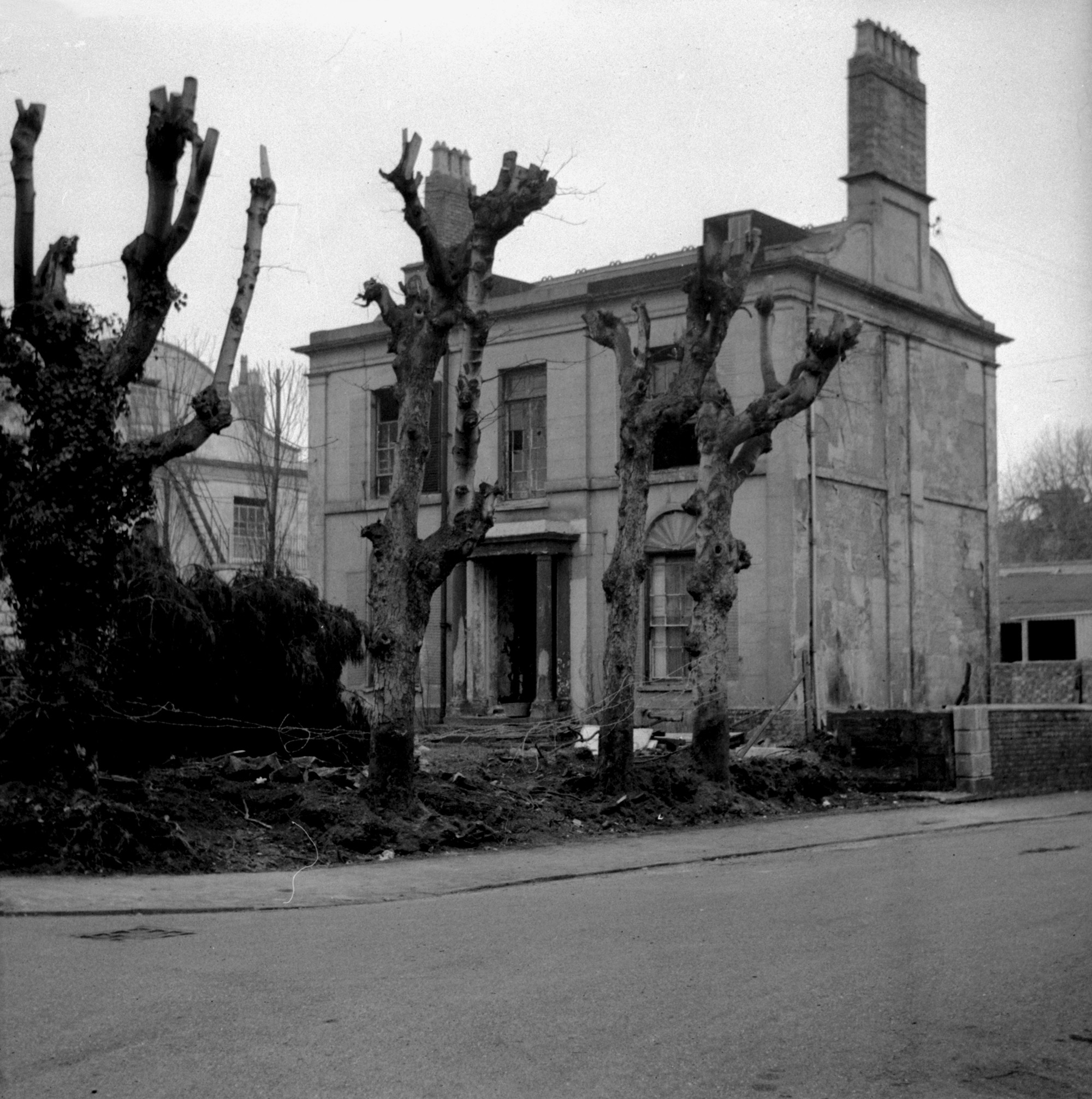 Eastbourne Lodge, 21st March, 1959. Photograph © R.H. Sargeant.
Eastbourne Lodge, 21st March, 1959. Photograph © R.H. Sargeant.
Eastbourne Lodge’s Residents
1871
The census for this year shows a whole household at Eastbourne Lodge:
Ambrose W. Knott, Attorney at Law
Sarah A. Knott, Housekeeper
Mary J. Barley, General Servant
Thomas Willshire, Servant
With visitors:
Catherine E. Knott
Francis A. Knott
Mary A. Baldwin
1896 – Littlebury’s Directory
Mrs. Meade King
1896
Eastbourne Lodge was changed from 51 to 54 Britannia Square.
1897 – Littlebury’s Directory
Mrs. Arnold
1908 – Littlebury’s Directory
W. S. Carless M.R.C.V.S., Veterinary Surgeon
1919 – Register of Electors
Reverend Henry Clement Sculthorpe
Harriette Frances Sculthorpe
1923 – Register of Electors
Eustace Roberts
1929 – Register of Electors
Horace J Parsons
Alice Parsons
Dorothy Isobel Parsons
1938 – London Gazette, the Companies Acts, Winding-up Orders
Registered Office of 1938 Bevere and City Dairies Limited, 27th May, 1938 – winding up order issued.
The most notable of residents is probably Richard Penrose Arnold, son of the literary critic and poet Matthew Arnold, who was a great friend of Edward Elgar and to whom ‘Variation V (R.P.A.) of Elgar’s Variations on an Original Theme, Op. 36’ (popularly known as the Enigma Variations) was dedicated. Whilst living at Eastbourne Lodge, Penrose was working as the local H.M. Inspector of Factories, but was ‘a great lover of music which he played (on the piano) in a self-taught manner, evading difficulties but suggesting in a mysterious way the real feeling. His serious conversation was continually broken up by whimsical and witty remarks.’
Edward Elgar in a letter to his publisher, Jaeger.
‘Strings, in one of Elgar’s most expansive and inspired melodies, represent Arnold’s nobility of mind and his deeply truthful way of playing music.’
Jane Jones, www.classicfm.com
Discovering Britannia Square’s Missing House
Whilst all the information about Eastbourne Lodge here is generally available, it came as a huge surprise to me to uncover it, and how this happened may perhaps be of some interest.
In 2016, with the assistance of former resident David Greenhill, I embarked on a project to gather together as many historical images of the Britannia Square area as I could find. The idea for such an undertaking stemmed from internet searches when I moved to Albany Terrace in 2012. I assumed, incorrectly as it transpired, that being such an historic and architecturally significant part of the city, there would be many images available. David had mentioned that for reasons related to his architectural practice he had previously consulted a collection called the Worcestershire Photographic Survey, which is where we started the search.
After struggling through microfiche, often with information difficult to see, and some slides missing entirely, I moved on to the hardcopy collections. In brief, after much time spent consulting records at the Hive and lengthy consultations with staff, copyright holders and photographers, I managed to assemble a number of images which forms the core of the Photographic Project on our website, which remains a work in progress. Whilst processing some of these images for the website, I came across several photographs of houses that I did not recognise, but being described as being located in Britannia Square, I included them with the specific detail missing, intending to add it at a later date.
One such image which caught my eye on first viewing was of a very dilapidated house, looking almost derelict. I remember thinking that it must have been an enormous task to have repaired it. I noted that it looked like other houses in the area, and so intended to return to it for more investigation at a later date. At this time, I wasn’t entirely familiar with all the houses on the square, so when I returned to this particular image, I was looking for clues. The main one was the distinctive ‘dutch gable’ style end wall of its neighbour, visible on the left-hand side of the photograph. I could only recall having seen one on the square, at St Oswald’s Lodge. I looked at photographs of St. Oswald’s, trying to see if the other mystery building was in the shot. Had the photograph perhaps been reverse printed? Others I found had been, but in any event, so far as I could see, the derelict house didn’t appear to be one of the houses adjacent to St. Oswald’s.
I decided to walk around the square to try to locate the mystery house. I started at St. Oswald’s and immediately felt a frisson of excitement. It really was one of those ‘hairs on the back of the neck standing up’ moments. To my amazement, it was clear that the gable end in the photograph was the right hand side of St. Oswald’s Lodge and the mystery house must have once been where Marlow Court was standing. On my next visit to The Hive, I was able to confirm it. Which is where this little story starts.
It transpired that the first image that I found was the March 1959 photograph (featured in the ‘time-lapse’ section of the ‘Britannia Square’s Missing House’ video). The last photograph found was the 1942 image, when the house seems, heartbreakingly, to be in good condition. It was a very poignant find, making even more evident the quality of Eastbourne Lodge and the great sadness of its loss. It also prompted a question: if it was important enough for the National Buildings Register to photograph in 1942, why wasn't it important enough to save?
The soundtrack for the video is the Richard Penrose Arnold theme from Elgar's Enigma Variations.
I have not spoken to everyone who may know of Eastbourne Lodge, but I have asked other residents and there seems to be little further information about it. I suppose that having been lost over 60 years ago, there may not be many people living in the area who would recall it, but should you have any stories about the house, I would love to hear from you. There is one brief recollection, by Nick Gilbert, whose family lived for many years at 1, Britannia Square, very close to the site of Eastbourne Lodge. Nick and his wife Ann have now moved away from the area, but before they left, Nick told me that he had played in the derelict house around 1959, when he was about ten years old, and that it was quite hazardous by then. He was also warned by his father that it was not safe to play there.
I should also say that Richard Lockett, in his ‘Origins of Britannia Square’ does briefly mention a ‘predecessor of the existing Marlowe (sic) Court', but I had not understood the full meaning of this and unfortunately didn't bring it to mind during my search.
It is well known that like other places, Worcester lost many significant and historic buildings in the 1950s and 60s, including the Cathedral Lych Gate (the last in the UK and reputedly the most intact in Europe) along with many other historic buildings in Friar Street, The Shambles and elsewhere around the city. The demolition of Eastbourne Lodge is a tragedy which surely ranks alongside these other losses. It is a reminder of how close the Britannia Square Conservation Area and its remarkable, precious environment came (anecdotally) to being entirely ‘re-developed’.
Although its loss is very sad, I am delighted to have made this discovery and very happy indeed to bring the story of such a beautiful, but sadly missing member of the Britannia Square family, to light and at least allow it to exist in the imagination.
We often describe Britannia Square as the only intact residential Regency square in the UK, which it is, except that it is missing just one particularly pretty house.
Robin Dallaway, BSRA website
robindallaway@gmail.com
With thanks to David Greenhill for help with the initial research, and to Ian Terry for his invaluable assistance regarding information from Registers of Electors, Census Records and Directory entries.
Music: Edward Elgar – Variation V (R.P.A.), Variations on an Original Theme, Op. 36. Performed by The Halle Orchestra conducted by John Barbirolli, 1st January, 1947.